What You Need to Know About Airline Pilot, Copilot, or Flight Engineer
Airline Pilot, Copilot, or Flight Engineer Definition Pilot and navigate the flight of fixed-wing, multi-engine aircraft, usually on scheduled air carrier routes, for the transport of passengers and cargo. Requires Federal Air Transport Pilot certificate and rating for specific aircraft type used. Includes regional, National, and international airline pilots and flight instructors of airline pilots.
List of Airline Pilot, Copilot, or Flight Engineer Job Duties
- Plan and formulate flight activities and test schedules and prepare flight evaluation reports.
- Steer aircraft along planned routes, using autopilot and flight management computers.
- Contact control towers for takeoff clearances, arrival instructions, and other information, using radio equipment.
- Check passenger and cargo distributions and fuel amounts to ensure that weight and balance specifications are met.
- File instrument flight plans with air traffic control to ensure that flights are coordinated with other air traffic.
- Record in log books information such as flight times, distances flown, and fuel consumption.
Featured schools near , edit
What Every Airline Pilot, Copilot, or Flight Engineer Should Know
When polled, Airline Pilots, Copilots, and Flight Engineers say the following skills are most frequently used in their jobs:
Operation and Control: Controlling operations of equipment or systems.
Operation Monitoring: Watching gauges, dials, or other indicators to make sure a machine is working properly.
Active Listening: Giving full attention to what other people are saying, taking time to understand the points being made, asking questions as appropriate, and not interrupting at inappropriate times.
Monitoring: Monitoring/Assessing performance of yourself, other individuals, or organizations to make improvements or take corrective action.
Critical Thinking: Using logic and reasoning to identify the strengths and weaknesses of alternative solutions, conclusions or approaches to problems.
Speaking: Talking to others to convey information effectively.
Related Job Titles
- Check Airman
- Systems Navigator
- Airline Captain
- Commercial Airline Pilot
- Captain Airline Pilot
Is There Going to be Demand for Airline Pilots, Copilots, and Flight Engineers?
There were about 84,000 jobs for Airline Pilot, Copilot, or Flight Engineer in 2016 (in the United States). New jobs are being produced at a rate of 3.5% which is below the national average. The Bureau of Labor Statistics predicts 2,900 new jobs for Airline Pilot, Copilot, or Flight Engineer by 2026. Due to new job openings and attrition, there will be an average of 8,100 job openings in this field each year.
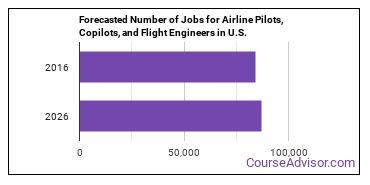
The states with the most job growth for Airline Pilot, Copilot, or Flight Engineer are Florida, New Jersey, and Georgia. Watch out if you plan on working in Wyoming, West Virginia, or New Hampshire. These states have the worst job growth for this type of profession.
Airline Pilot, Copilot, or Flight Engineer Average Salary
The typical yearly salary for Airline Pilots, Copilots, and Flight Engineers is somewhere between $65,690 and $208,000.
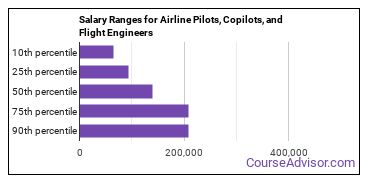
Airline Pilots, Copilots, and Flight Engineers who work in Michigan, Nevada, or Oregon, make the highest salaries.
Below is a list of the median annual salaries for Airline Pilots, Copilots, and Flight Engineers in different U.S. states.
| State | Annual Mean Salary |
|---|---|
| Alabama | $103,750 |
| Alaska | $148,820 |
| Arizona | $132,250 |
| Arkansas | $96,690 |
| California | $205,520 |
| Colorado | $196,670 |
| Connecticut | $116,930 |
| Florida | $188,400 |
| Illinois | $193,600 |
| Indiana | $124,270 |
| Iowa | $118,700 |
| Kansas | $102,190 |
| Louisiana | $101,010 |
| Michigan | $233,550 |
| Minnesota | $103,930 |
| Mississippi | $94,760 |
| Missouri | $123,820 |
| Nebraska | $106,480 |
| Nevada | $220,400 |
| New Hampshire | $122,810 |
| New Mexico | $163,030 |
| New York | $108,420 |
| North Carolina | $102,660 |
| North Dakota | $104,660 |
| Ohio | $119,320 |
| Oklahoma | $107,960 |
| Oregon | $205,660 |
| Pennsylvania | $151,390 |
| South Carolina | $102,990 |
| Tennessee | $85,550 |
| Texas | $200,320 |
| Utah | $104,230 |
| Washington | $237,150 |
| West Virginia | $85,490 |
| Wisconsin | $106,240 |
What Tools & Technology do Airline Pilots, Copilots, and Flight Engineers Use?
Below is a list of the types of tools and technologies that Airline Pilots, Copilots, and Flight Engineers may use on a daily basis:
- Microsoft Excel
- Microsoft Word
- Microsoft Office
- Microsoft PowerPoint
- Microsoft Outlook
- Microsoft Visio
- SBS International Maestro Suite
- RMS Technology Flitesoft
- MJICCS PilotLog
- Nimblefeet Technologies Captain’s Keeper
- Electronic aircraft information databases
- Polaris Microsystems CharterLog
- AirSmith FlightPrompt
- Skylog Services Skylog Pro
- doXstor Flight Level Logbook
- AeroPlanner
- Notam Development Group Airport Insight
- Navzilla
- Pilot Navigator Software Load Balance
- Polaris Microsystems AeroLog Pro
How to Become an Airline Pilot, Copilot, or Flight Engineer
Individuals working as an Airline Pilot, Copilot, or Flight Engineer have obtained the following education levels:
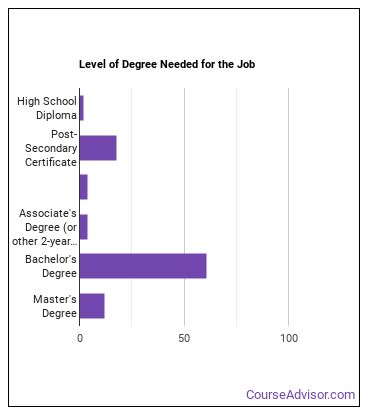
How Long Does it Take to Become an Airline Pilot, Copilot, or Flight Engineer?
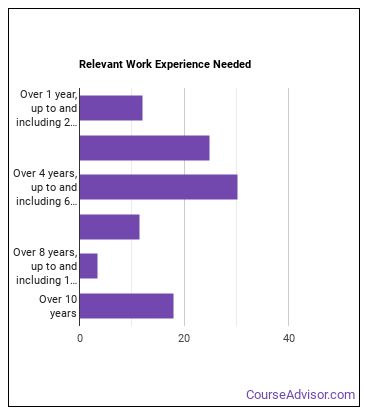
Where do Airline Pilots, Copilots, and Flight Engineers Work?
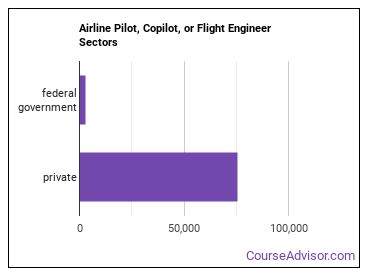
Airline Pilots, Copilots, and Flight Engineers work in the following industries:
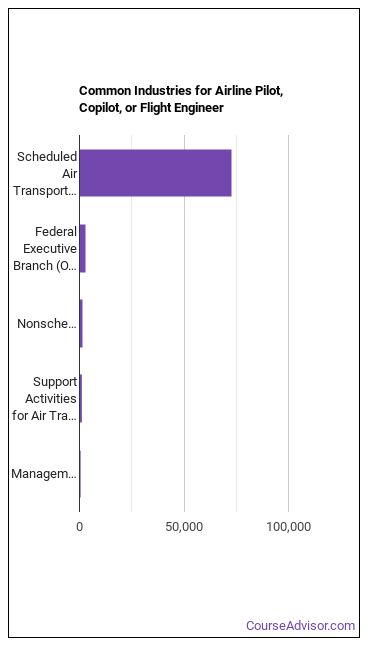
References:
Image Credit: Tech. Sgt. Scott T. Sturkol via U.S. Air Force photo
More about our data sources and methodologies.
Featured Schools
 Request Info
Request Info
|
Southern New Hampshire University You have goals. Southern New Hampshire University can help you get there. Whether you need a bachelor's degree to get into a career or want a master's degree to move up in your current career, SNHU has an online program for you. Find your degree from over 200 online programs. Learn More > |
